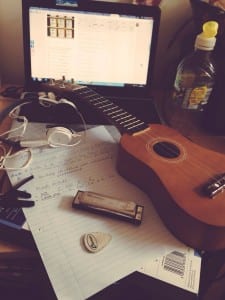To adhere to our mission of ‘depicting real stories in an alternative light’ (Refract, 2015) we had to establish a combination of fragmentation and through-lines in our practical development. Fragmentation has occurred in our practical work by focusing on a variety of past and current events to ‘shine light on the spectrum of opportunity’ (Refract, 2015). However a through-line has been an essential development in our process, to define our ethos of ‘storytelling’; a factor which an audience may appreciate and value when experiencing theatre. The through-line acts as a developing story whereas our fragments aim to ‘refract your view’; not having a through-line could make it difficult for an audience to comprehend and draw meaning to our fragmented style. I will continue to discuss this from my perceptive as an Actor and Sound Designer separately.
An Actor’s perceptive:
The introduction of Billy and Dolly’s story as a through-line allowed us as actors to establish more emotional connections to our own characters and scenes we have previously created. The sequences we had created undoubtedly worked individually but it became difficult to envision them all put together for one performance. The representation of Billy and Dolly’s relationship triggered an understanding of other scenes and characters we have previously created, showing that the through-line kick started the shape of our final piece. The developments in our practical work have continually shaped the role of the actor, despite talking about performing emotion; I would say as actors, we are far from traditional. The physical and fragmented style of our piece has developed us from actors into creators.
A Sound Designer’s perspective
Introducing Billy and Dolly’s relationship as a through-line has radically helped me to define specific moments for sound. As we have devised our piece in fragments, it has been difficult as a Sound Designer to envision a thorough sound plan and style which flows in between each sequence. The through-line finally enabled me to visualise the style of sound needed to reinforce the piece. I was set the task to create a melody as a signifier for specific Billy and Dolly moments, where I was advised by Laura to create a tune, similar to the other acoustic sounds featured in the performance in order to establish consistency. I have used my Ukulele and Harmonica with the intention to add Guitar for this task, along with researching songs, styles, noting chords down, mixing and experimenting; all in order to create melodies which could represent Billy and Dolly’s relationship without Tom and Amy even having to be on stage. The addition of the through-line allowed us to envision the first stages of a complete piece. It has allowed us to visualise the performance as a whole concept, where more creative decisions can be made more definitely.

“Refract is opening your eyes to new possibilities… Refract is shining a light and viewing the spectrum of opportunity. Refract is storytelling” (Refract, 2015)
Works Cited
Refract (2015) Refract Theatre Company Blog. [online] Available from https://refracttheatrecompany.blogs.lincoln.ac.uk/ [Accessed 23 April 2015]
Tait, P (2008) ‘Bodies Perform Inner Emotions: Stanislavski’s Legacy’. Australasian Drama Studies 53, 84-102.